金融专业外文翻译---资本结构的影响因素
- 格式:doc
- 大小:54.00 KB
- 文档页数:11
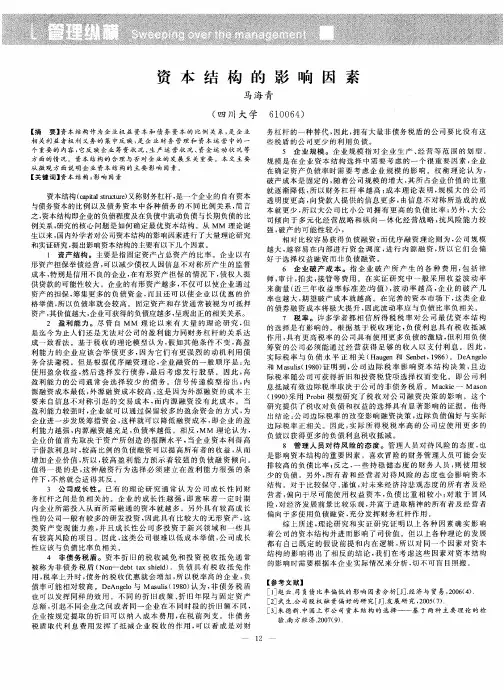

---文档均为word文档,下载后可直接编辑使用亦可打印---一、绪论(一)选题背景及目的商业银行(Commercial Bank),英文缩写是CB,是银行的一种类型;商业银行也是一个企业,它以营利为目的,在金融全球化的背景下,中国经济市场发展迅速,越来越多的外国银行涌入中国,造成国内金融市场竞争激烈;我国商业银行想要稳健持久的发展,进行内部资本结构调整和优化是必不可少的。
本文以中信银行为研究对象,对中信银行的资产结构进行了综合分析,并和招商银行进行对比,希望通过对财务管理的专业理解来找到问题以及影响因素,并提出有用的建议。
(二)国内外研究现状1、国内研究现状基于MM理论的商业银行资本结构分析。
如吴子含(2018)在《商业银行资本结构分析》中指出,商业银行的资本结构不仅直接影响其持续稳健经营,也关乎金融体系的安全。
以MM理论为指导,该理论认为在一个不存在破产成本和税收的“完美资本市场”中,公司的价值与其资本结构无关。
分析了政府政策对商业银行资本结构决定的影响,以及五大国有商业银行核心资本现状,得出增加内源资本是商业银行补充核心资本的主要方式[1]。
通过微观和宏观两个层面对商业银行资本结构进行分析。
如宋鹏(2018)在《商业银行资本结构影响因素分析——以我国上市银行为例》论文中,通过对16家上市银行数据进行实证分析后得出,对资本结构的定义有三种主要表述,分别为资产负债率、股东权益比、产权比率。
资产负债率主要反映的是借债方式筹资在总资产中所占的比例大小;股东权益比主要反映所有者提供的资本在总资产中所占的比重大小;产权比率可充分反映总资产中家宅资本与所有者提供的资本比率,并合理的衡量企业的资金结构。
同时,他还选取了银行规模、成长性、盈利能力、资本充足性、资本成本、资产风险、非债务税遁、股权集中9个指标;宏观层面选取了发展潜力、风险控制、税盾效应、宏观影响4个主要成分;运用面板回归分析法进行分析[2]。
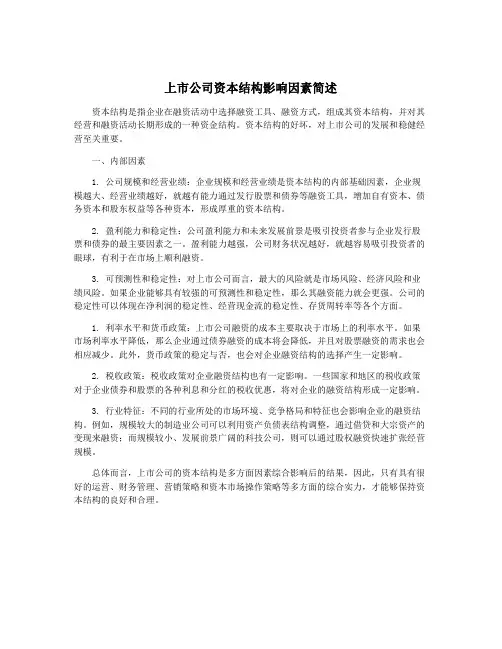
上市公司资本结构影响因素简述资本结构是指企业在融资活动中选择融资工具、融资方式,组成其资本结构,并对其经营和融资活动长期形成的一种资金结构。
资本结构的好坏,对上市公司的发展和稳健经营至关重要。
一、内部因素1. 公司规模和经营业绩:企业规模和经营业绩是资本结构的内部基础因素,企业规模越大、经营业绩越好,就越有能力通过发行股票和债券等融资工具,增加自有资本、债务资本和股东权益等各种资本,形成厚重的资本结构。
2. 盈利能力和稳定性:公司盈利能力和未来发展前景是吸引投资者参与企业发行股票和债券的最主要因素之一。
盈利能力越强,公司财务状况越好,就越容易吸引投资者的眼球,有利于在市场上顺利融资。
3. 可预测性和稳定性:对上市公司而言,最大的风险就是市场风险、经济风险和业绩风险。
如果企业能够具有较强的可预测性和稳定性,那么其融资能力就会更强。
公司的稳定性可以体现在净利润的稳定性、经营现金流的稳定性、存货周转率等各个方面。
1. 利率水平和货币政策:上市公司融资的成本主要取决于市场上的利率水平。
如果市场利率水平降低,那么企业通过债券融资的成本将会降低,并且对股票融资的需求也会相应减少。
此外,货币政策的稳定与否,也会对企业融资结构的选择产生一定影响。
2. 税收政策:税收政策对企业融资结构也有一定影响。
一些国家和地区的税收政策对于企业债券和股票的各种利息和分红的税收优惠,将对企业的融资结构形成一定影响。
3. 行业特征:不同的行业所处的市场环境、竞争格局和特征也会影响企业的融资结构。
例如,规模较大的制造业公司可以利用资产负债表结构调整,通过借贷和大宗资产的变现来融资;而规模较小、发展前景广阔的科技公司,则可以通过股权融资快速扩张经营规模。
总体而言,上市公司的资本结构是多方面因素综合影响后的结果,因此,只有具有很好的运营、财务管理、营销策略和资本市场操作策略等多方面的综合实力,才能够保持资本结构的良好和合理。
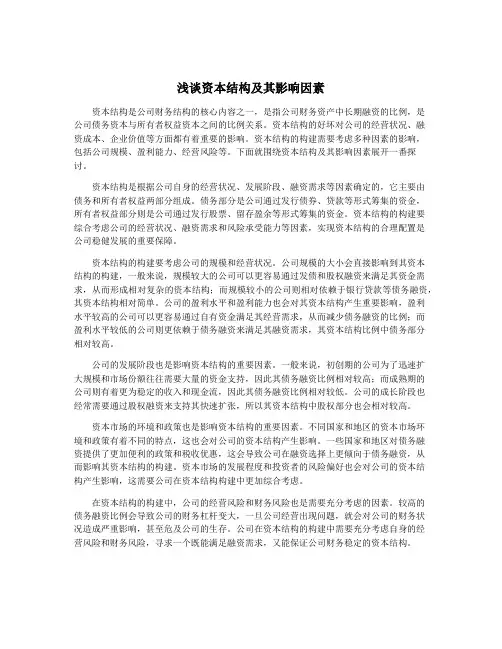
浅谈资本结构及其影响因素资本结构是公司财务结构的核心内容之一,是指公司财务资产中长期融资的比例,是公司债务资本与所有者权益资本之间的比例关系。
资本结构的好坏对公司的经营状况、融资成本、企业价值等方面都有着重要的影响。
资本结构的构建需要考虑多种因素的影响,包括公司规模、盈利能力、经营风险等。
下面就围绕资本结构及其影响因素展开一番探讨。
资本结构是根据公司自身的经营状况、发展阶段、融资需求等因素确定的,它主要由债务和所有者权益两部分组成。
债务部分是公司通过发行债券、贷款等形式筹集的资金,所有者权益部分则是公司通过发行股票、留存盈余等形式筹集的资金。
资本结构的构建要综合考虑公司的经营状况、融资需求和风险承受能力等因素,实现资本结构的合理配置是公司稳健发展的重要保障。
资本结构的构建要考虑公司的规模和经营状况。
公司规模的大小会直接影响到其资本结构的构建,一般来说,规模较大的公司可以更容易通过发债和股权融资来满足其资金需求,从而形成相对复杂的资本结构;而规模较小的公司则相对依赖于银行贷款等债务融资,其资本结构相对简单。
公司的盈利水平和盈利能力也会对其资本结构产生重要影响,盈利水平较高的公司可以更容易通过自有资金满足其经营需求,从而减少债务融资的比例;而盈利水平较低的公司则更依赖于债务融资来满足其融资需求,其资本结构比例中债务部分相对较高。
公司的发展阶段也是影响资本结构的重要因素。
一般来说,初创期的公司为了迅速扩大规模和市场份额往往需要大量的资金支持,因此其债务融资比例相对较高;而成熟期的公司则有着更为稳定的收入和现金流,因此其债务融资比例相对较低。
公司的成长阶段也经常需要通过股权融资来支持其快速扩张,所以其资本结构中股权部分也会相对较高。
资本市场的环境和政策也是影响资本结构的重要因素。
不同国家和地区的资本市场环境和政策有着不同的特点,这也会对公司的资本结构产生影响。
一些国家和地区对债务融资提供了更加便利的政策和税收优惠,这会导致公司在融资选择上更倾向于债务融资,从而影响其资本结构的构建。
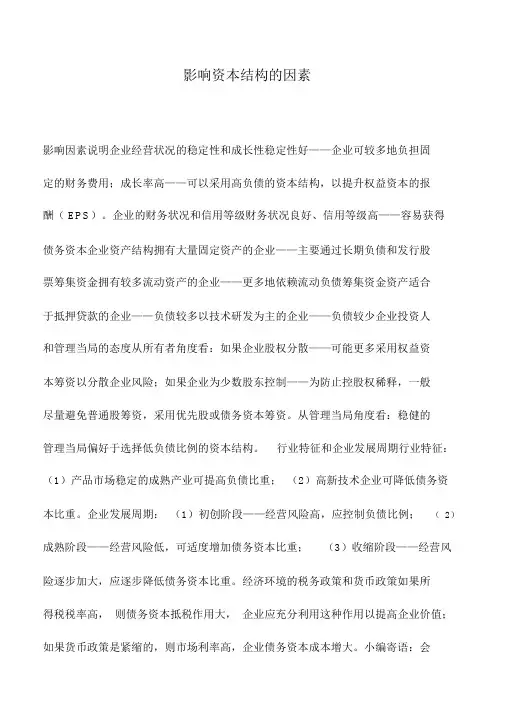
影响资本结构的因素影响因素说明企业经营状况的稳定性和成长性稳定性好——企业可较多地负担固定的财务费用;成长率高——可以采用高负债的资本结构,以提升权益资本的报酬( EPS)。
企业的财务状况和信用等级财务状况良好、信用等级高——容易获得债务资本企业资产结构拥有大量固定资产的企业——主要通过长期负债和发行股票筹集资金拥有较多流动资产的企业——更多地依赖流动负债筹集资金资产适合于抵押贷款的企业——负债较多以技术研发为主的企业——负债较少企业投资人和管理当局的态度从所有者角度看:如果企业股权分散——可能更多采用权益资本筹资以分散企业风险;如果企业为少数股东控制——为防止控股权稀释,一般尽量避免普通股筹资,采用优先股或债务资本筹资。
从管理当局角度看:稳健的管理当局偏好于选择低负债比例的资本结构。
行业特征和企业发展周期行业特征:(1)产品市场稳定的成熟产业可提高负债比重;(2)高新技术企业可降低债务资本比重。
企业发展周期:(1)初创阶段——经营风险高,应控制负债比例;(2)成熟阶段——经营风险低,可适度增加债务资本比重;(3)收缩阶段——经营风险逐步加大,应逐步降低债务资本比重。
经济环境的税务政策和货币政策如果所得税税率高,则债务资本抵税作用大,企业应充分利用这种作用以提高企业价值;如果货币政策是紧缩的,则市场利率高,企业债务资本成本增大。
小编寄语:会计学是一个细节致命的学科,以前总是觉得只要大概知道意思就可以了,但这样是很难达到学习要求的。
因为它是一门技术很强的课程,主要阐述会计核算的基本业务方法。
诚然,困难不能否认,但只要有了正确的学习方法和积极的学习态度,最后加上勤奋,那样必然会赢来成功的曙光。
天道酬勤嘛!。
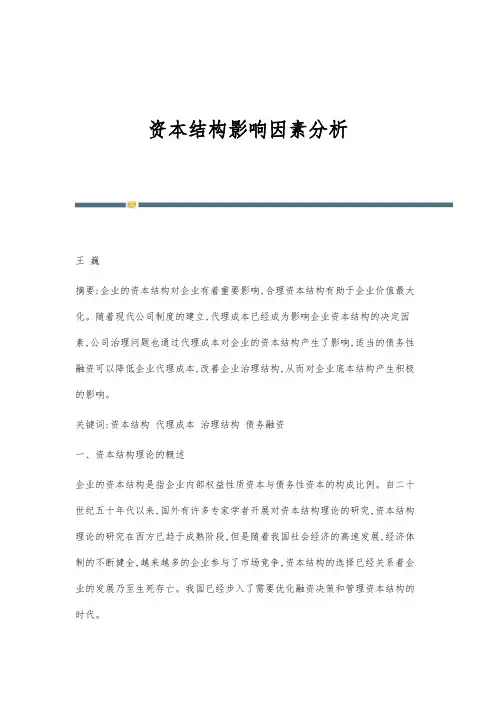
资本结构影响因素分析王巍摘要:企业的资本结构对企业有着重要影响,合理资本结构有助于企业价值最大化。
随着现代公司制度的建立,代理成本已经成为影响企业资本结构的决定因素,公司治理问题也通过代理成本对企业的资本结构产生了影响,适当的债务性融资可以降低企业代理成本,改善企业治理结构,从而对企业底本结构产生积极的影响。
关键词:资本结构代理成本治理结构债务融资一、资本结构理论的概述企业的资本结构是指企业内部权益性质资本与债务性资本的构成比例。
自二十世纪五十年代以来,国外有许多专家学者开展对资本结构理论的研究,资本结构理论的研究在西方已趋于成熟阶段,但是随着我国社会经济的高速发展,经济体制的不断健全,越来越多的企业参与了市场竞争,资本结构的选择已经关系着企业的发展乃至生死存亡。
我国已经步入了需要优化融资决策和管理资本结构的时代。
资本结构理论是企业财务理论的重要内容,并经历了一个逐步形成不断发展和完善的过程:MM理论,权衡理论,ROSS信号理论,控制权转移理论等,那么究竟哪些因素影响企业的资本结构?这一问题的解决,对于公司的经营者以及投资者都具有重要的现实意义。
二、资本结构影响因素的探讨(一)代理成本对资本结构的影响资本结构的代理成本理论是由詹森(Jensen)和麦克林(Meckling)于1976年提出的。
他们认为“代理成本”是企业资本结构的决定因素。
但是对于理论成本怎么影响资本结构却未做出详细地分析。
随着现在公司制度的建立,代理成本问题已经成为现代企业资本结构决策必须考虑的问题,对于代理成本是怎么影响资本结构,首先要从代理成本的产生入手。
代理成本的产生通常是由股东和管理者的利益冲突;股东和债权人的利益冲突引起的。
在现在公司之下,企业的所有者与经营者分离,企业的经营者一般不是企业的完全所有者,经理们在承担了全部责任和风险后,所获得的只是全部利润的一部分,所以管理者的利益冲突主要表现为:1.经理偏好更多的额外收入和更低的努力程度,因为经营不佳,他们付出的成本只是较低的工资和较低的个人持有股票的市场价值。
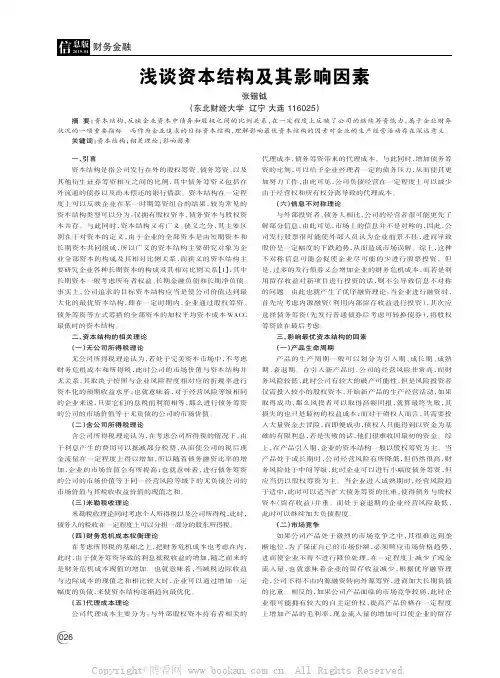
一、引言资本结构是指公司发行在外的股权筹资、债务筹资、以及其他衍生证券筹资相互之间的比例,其中债务筹资又包括在外流通的债券以及尚未偿还的银行借款。
资本结构在一定程度上可以反映企业在某一时期筹资组合的结果,较为常见的资本结构类型可以分为:仅拥有股权资本,债务资本与股权资本并存。
与此同时,资本结构又有广义、狭义之分,其主要区别在于对资本的定义,由于企业的全部资本是由短期资本和长期资本共同组成,所以广义的资本结构主要研究对象为企业全部资本的构成及其相对比例关系,而狭义的资本结构主要研究企业各种长期资本的构成及其相对比例关系【1】;其中长期资本一般考虑所有者权益、长期金融负债和长期净负债。
事实上,公司追求的目标资本结构应当是使公司价值达到最大化的最优资本结构,即在一定时期内,企业通过股权筹资、债务筹资等方式筹措的全部资本的加权平均资本成本WACC 最低时的资本结构。
二、资本结构的相关理论(一)无公司所得税理论无公司所得税理论认为,若处于完美资本市场中,不考虑财务危机成本和所得税,此时公司的市场价值与资本结构并无关系,其取决于按照与企业风险程度相对应的折现率进行资本化的预期收益水平;也就意味着,对于经营风险等级相同的企业来说,只要它们的息税前利润相等,那么进行债务筹资的公司的市场价值等于无负债的公司的市场价值。
(二)含公司所得税理论含公司所得税理论认为,在考虑公司所得税的情况下,由于利息产生的费用可以抵减部分税费,从而使公司的税后现金流量在一定程度上得以增加,所以随着债务融资比率的增加,企业的市场价值会有所提高;也就意味着,进行债务筹资的公司的市场价值等于同一经营风险等级下的无负债公司的市场价值与其税收收益价值的现值之和。
(三)米勒税收理论米勒税收理论同时考虑个人所得税以及公司所得税,此时,债务人的税收在一定程度上可以分担一部分的股东所得税。
(四)财务危机成本权衡理论在考虑所得税的基础之上,把财务危机成本也考虑在内,此时,由于债务筹资导致的利息抵税收益的增加,随之而来的是财务危机成本现值的增加。
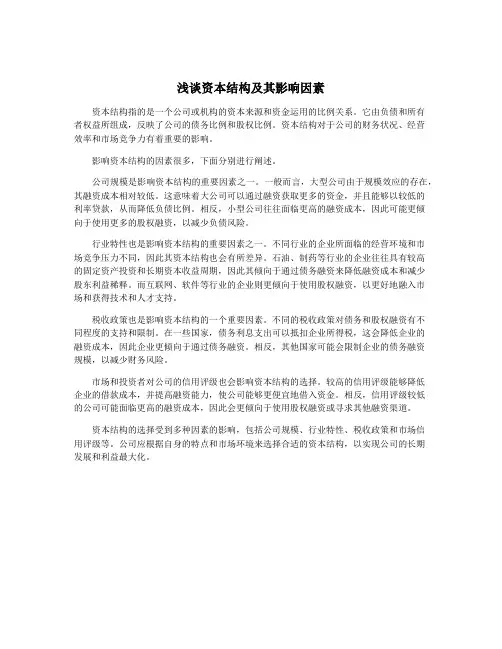
浅谈资本结构及其影响因素资本结构指的是一个公司或机构的资本来源和资金运用的比例关系。
它由负债和所有者权益所组成,反映了公司的债务比例和股权比例。
资本结构对于公司的财务状况、经营效率和市场竞争力有着重要的影响。
影响资本结构的因素很多,下面分别进行阐述。
公司规模是影响资本结构的重要因素之一。
一般而言,大型公司由于规模效应的存在,其融资成本相对较低。
这意味着大公司可以通过融资获取更多的资金,并且能够以较低的利率贷款,从而降低负债比例。
相反,小型公司往往面临更高的融资成本,因此可能更倾向于使用更多的股权融资,以减少负债风险。
行业特性也是影响资本结构的重要因素之一。
不同行业的企业所面临的经营环境和市场竞争压力不同,因此其资本结构也会有所差异。
石油、制药等行业的企业往往具有较高的固定资产投资和长期资本收益周期,因此其倾向于通过债务融资来降低融资成本和减少股东利益稀释。
而互联网、软件等行业的企业则更倾向于使用股权融资,以更好地融入市场和获得技术和人才支持。
税收政策也是影响资本结构的一个重要因素。
不同的税收政策对债务和股权融资有不同程度的支持和限制。
在一些国家,债务利息支出可以抵扣企业所得税,这会降低企业的融资成本,因此企业更倾向于通过债务融资。
相反,其他国家可能会限制企业的债务融资规模,以减少财务风险。
市场和投资者对公司的信用评级也会影响资本结构的选择。
较高的信用评级能够降低企业的借款成本,并提高融资能力,使公司能够更便宜地借入资金。
相反,信用评级较低的公司可能面临更高的融资成本,因此会更倾向于使用股权融资或寻求其他融资渠道。
资本结构的选择受到多种因素的影响,包括公司规模、行业特性、税收政策和市场信用评级等。
公司应根据自身的特点和市场环境来选择合适的资本结构,以实现公司的长期发展和利益最大化。
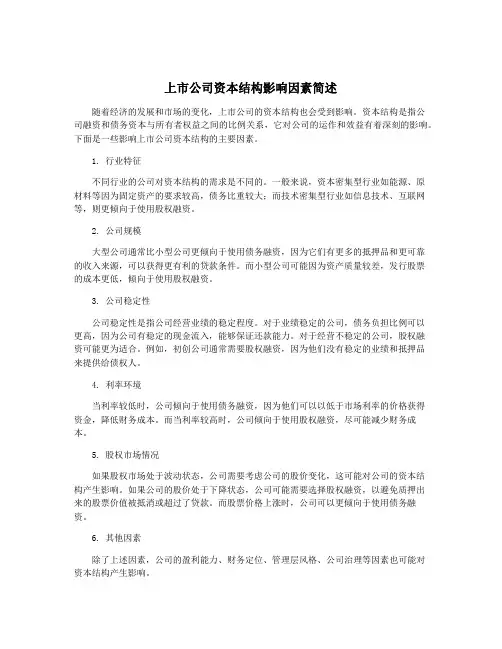
上市公司资本结构影响因素简述随着经济的发展和市场的变化,上市公司的资本结构也会受到影响。
资本结构是指公司融资和债务资本与所有者权益之间的比例关系,它对公司的运作和效益有着深刻的影响。
下面是一些影响上市公司资本结构的主要因素。
1. 行业特征不同行业的公司对资本结构的需求是不同的。
一般来说,资本密集型行业如能源、原材料等因为固定资产的要求较高,债务比重较大;而技术密集型行业如信息技术、互联网等,则更倾向于使用股权融资。
2. 公司规模大型公司通常比小型公司更倾向于使用债务融资,因为它们有更多的抵押品和更可靠的收入来源,可以获得更有利的贷款条件。
而小型公司可能因为资产质量较差,发行股票的成本更低,倾向于使用股权融资。
3. 公司稳定性公司稳定性是指公司经营业绩的稳定程度。
对于业绩稳定的公司,债务负担比例可以更高,因为公司有稳定的现金流入,能够保证还款能力。
对于经营不稳定的公司,股权融资可能更为适合。
例如,初创公司通常需要股权融资,因为他们没有稳定的业绩和抵押品来提供给债权人。
4. 利率环境当利率较低时,公司倾向于使用债务融资,因为他们可以以低于市场利率的价格获得资金,降低财务成本。
而当利率较高时,公司倾向于使用股权融资,尽可能减少财务成本。
5. 股权市场情况如果股权市场处于波动状态,公司需要考虑公司的股价变化,这可能对公司的资本结构产生影响。
如果公司的股价处于下降状态,公司可能需要选择股权融资,以避免质押出来的股票价值被抵消或超过了贷款。
而股票价格上涨时,公司可以更倾向于使用债务融资。
6. 其他因素除了上述因素,公司的盈利能力、财务定位、管理层风格、公司治理等因素也可能对资本结构产生影响。
总之,上市公司的资本结构会受到多方面的影响,需要公司根据自身情况进行合理的选择。
正确的资本结构可以帮助公司获得更低的融资成本和更好的财务收益,提高公司的竞争力和价值。
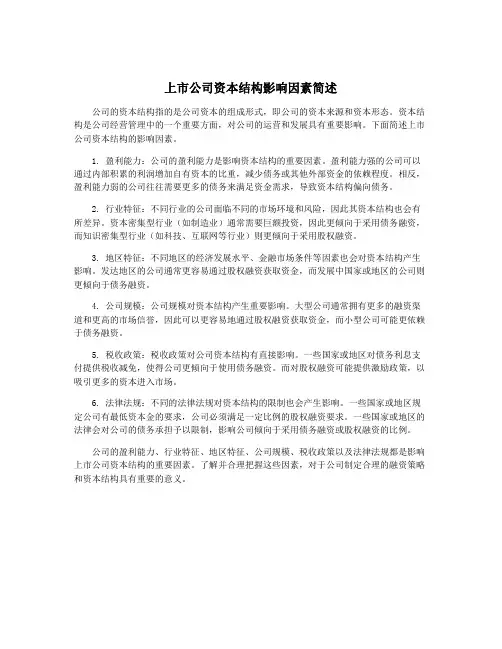
上市公司资本结构影响因素简述公司的资本结构指的是公司资本的组成形式,即公司的资本来源和资本形态。
资本结构是公司经营管理中的一个重要方面,对公司的运营和发展具有重要影响。
下面简述上市公司资本结构的影响因素。
1. 盈利能力:公司的盈利能力是影响资本结构的重要因素。
盈利能力强的公司可以通过内部积累的利润增加自有资本的比重,减少债务或其他外部资金的依赖程度。
相反,盈利能力弱的公司往往需要更多的债务来满足资金需求,导致资本结构偏向债务。
2. 行业特征:不同行业的公司面临不同的市场环境和风险,因此其资本结构也会有所差异。
资本密集型行业(如制造业)通常需要巨额投资,因此更倾向于采用债务融资,而知识密集型行业(如科技、互联网等行业)则更倾向于采用股权融资。
3. 地区特征:不同地区的经济发展水平、金融市场条件等因素也会对资本结构产生影响。
发达地区的公司通常更容易通过股权融资获取资金,而发展中国家或地区的公司则更倾向于债务融资。
4. 公司规模:公司规模对资本结构产生重要影响。
大型公司通常拥有更多的融资渠道和更高的市场信誉,因此可以更容易地通过股权融资获取资金,而小型公司可能更依赖于债务融资。
5. 税收政策:税收政策对公司资本结构有直接影响。
一些国家或地区对债务利息支付提供税收减免,使得公司更倾向于使用债务融资。
而对股权融资可能提供激励政策,以吸引更多的资本进入市场。
6. 法律法规:不同的法律法规对资本结构的限制也会产生影响。
一些国家或地区规定公司有最低资本金的要求,公司必须满足一定比例的股权融资要求。
一些国家或地区的法律会对公司的债务承担予以限制,影响公司倾向于采用债务融资或股权融资的比例。
公司的盈利能力、行业特征、地区特征、公司规模、税收政策以及法律法规都是影响上市公司资本结构的重要因素。
了解并合理把握这些因素,对于公司制定合理的融资策略和资本结构具有重要的意义。
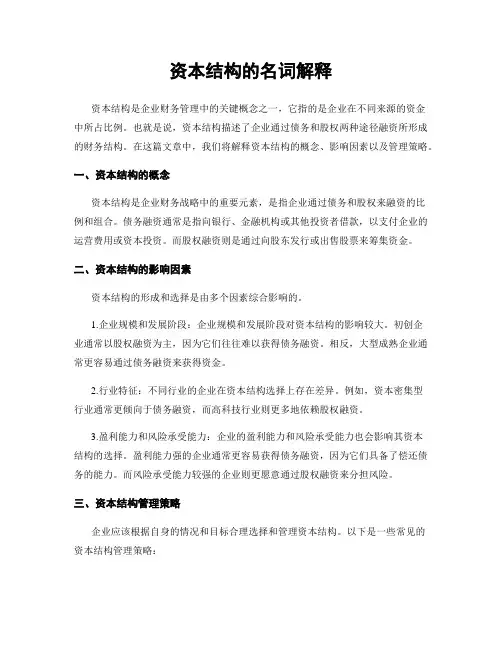
资本结构的名词解释资本结构是企业财务管理中的关键概念之一,它指的是企业在不同来源的资金中所占比例。
也就是说,资本结构描述了企业通过债务和股权两种途径融资所形成的财务结构。
在这篇文章中,我们将解释资本结构的概念、影响因素以及管理策略。
一、资本结构的概念资本结构是企业财务战略中的重要元素,是指企业通过债务和股权来融资的比例和组合。
债务融资通常是指向银行、金融机构或其他投资者借款,以支付企业的运营费用或资本投资。
而股权融资则是通过向股东发行或出售股票来筹集资金。
二、资本结构的影响因素资本结构的形成和选择是由多个因素综合影响的。
1.企业规模和发展阶段:企业规模和发展阶段对资本结构的影响较大。
初创企业通常以股权融资为主,因为它们往往难以获得债务融资。
相反,大型成熟企业通常更容易通过债务融资来获得资金。
2.行业特征:不同行业的企业在资本结构选择上存在差异。
例如,资本密集型行业通常更倾向于债务融资,而高科技行业则更多地依赖股权融资。
3.盈利能力和风险承受能力:企业的盈利能力和风险承受能力也会影响其资本结构的选择。
盈利能力强的企业通常更容易获得债务融资,因为它们具备了偿还债务的能力。
而风险承受能力较强的企业则更愿意通过股权融资来分担风险。
三、资本结构管理策略企业应该根据自身的情况和目标合理选择和管理资本结构。
以下是一些常见的资本结构管理策略:1.整合债务和股权融资:企业可以通过整合债务和股权融资来实现最优的资本结构。
这样可以充分利用两种融资方式的优势,例如债务融资的低成本和股权融资的风险分散。
2.财务杠杆效应:财务杠杆效应指的是通过债务融资来提高企业的盈利能力和股东回报率。
企业可以通过适量的债务融资来提高财务杠杆效应,并获得更高的收益率。
3.风险管理:企业在管理资本结构时应注意风险管理。
过度债务融资可能导致企业承担过多的财务风险,而纯股权融资则可能降低企业的偿债能力。
因此,企业应根据自身风险承受能力和行业特点来合理分配债务和股权比例。
上市公司资本结构影响因素简述上市公司的资本结构是指公司融资的组成部分及其占比,也是公司财务管理的重要内容之一。
资本结构的优化对于公司的经营活动和发展战略起着至关重要的作用。
资本结构的形成受到多种因素的影响,这些因素包括公司自身的特点、行业环境、宏观经济环境等。
本文将从多个角度简述上市公司资本结构的影响因素。
一、公司自身的特点1. 公司规模公司的规模对资本结构有很大的影响。
一般来说,规模较大的公司会更多地注重债务融资,因为规模较大的公司有更多的经营项目和资产支持,债务融资成本相对更低,并且规模较大的公司更容易被资本市场接受。
而规模较小的公司则更多地依赖股权融资,因为规模较小的公司往往缺乏足够的抵押品和信用担保,债务融资成本相对较高。
2. 盈利能力盈利能力是公司资本结构的重要影响因素之一。
盈利能力越强的公司在融资时更容易取得债务融资,并且承担较少的风险。
相反,盈利能力较差的公司更多地依赖股权融资,因为这样可以减少其财务风险。
3. 成长性成长性强的公司更多地依赖债务融资,因为未来的盈利能力可以支持公司偿还债务。
而成长性较弱的公司更多地依赖股权融资,因为这样可以降低公司的财务风险。
4. 资产结构资产结构的不同也会对资本结构产生影响。
如果公司的资产主要以不动产、设备等有形固定资产为主,那么债务融资相对更容易;如果公司的资产主要是以无形资产和知识产权为主,那么股权融资可能更合适。
二、行业环境1. 行业特点不同行业的特点对资本结构的影响也很大。
一般来说,对于稳定盈利的行业,公司更倾向于使用债务融资,因为这样可以降低成本;而对于高增长性行业,公司更倾向于使用股权融资,因为这样可以降低财务风险。
三、宏观经济环境1. 利率水平利率水平对资本结构有很大的影响。
通常情况下,利率较低时,公司更倾向于使用债务融资;利率较高时,公司更倾向于使用股权融资。
3. 政策和法律环境政策和法律环境对资本结构的影响也很大。
不同国家和地区的政策法规对企业融资有不同的限制和要求,对资本结构有很大的影响。
金融学中的资本结构资本结构是企业融资中非常重要的一个概念。
它是企业长期融资与短期融资的组成部分,是企业在进行投资活动时所需要的资金来源。
资本结构的优劣与企业融资的成本、风险以及财务状况密切相关,因此,在金融学中,资本结构成为了一个重要的研究领域。
资本结构的定义与组成资本结构是企业融资中资本所占比重及其种类。
具体来说,资本结构通常由两部分组成,即股本与债务。
股本包括了企业向股东发行的普通股和优先股等权益性资本。
债务则是企业通过向各种金融机构发行债券、贷款等的借款或租赁等工具来形成的负债性资本。
资本结构与企业价值资本结构与企业的价值密切相关。
企业的股东倾向于追求资产收益率(rOA)最大化,而资本成本(WACC)则是企业选择债权和股权之间的最佳平衡点。
如果企业选择过多的股权融资,将会导致成本过高、股东收益偏低,甚至可能影响企业的独立性和生存能力。
相反,选择过多的债务融资将会导致企业的杠杆比率过高,增加了偿付风险,也可能影响企业的生存能力。
因此,企业必须在资本结构中找到平衡点,以提高投资者的收益,同时保持企业的偿债能力和盈利能力。
资本结构决策资本结构的决策过程通常是企业在决定长期资金需要量的基础上,同时考虑融资成本和将来偿还能力,以决定长期资金融资的规模和方式。
一般来说,资本结构决策涉及到企业的融资目标、偿债能力、资产负债表的状况,以及有关金融机构、投资者、信用评级机构等多个节点的制约和影响。
影响资本结构的因素资本结构的决策受到多种因素的影响。
经济环境、金融市场、财务状况、行业特点等因素都会影响资本结构的形成和演变。
一般来说,企业在决策资本结构时需要考虑以下因素:1. 融资成本融资成本是决策资本结构的首要考虑因素。
不同融资方式的融资成本之间会存在差异,企业的资本结构优化需要通过分析融资成本,选择最优的资本来源。
2. 偿债能力企业的偿债能力也是重要的决策因素。
是企业在选择债务融资时需要考虑的核心因素,需要通过分析企业的盈利能力、现金流情况以及其他相关指标,确保债务偿还能力。
外文翻译原文The analysis of company's capital and evaluation of factors, which influencecreation of the optimal capital structureMaterial Source: Author: Svetlana Saksonova This is the primary information gathering stage, which is necessary for the effective planning afterwards. At this stage the objective of the financial manager is to determine the existing tendencies of the development of capital structure, as well as its volume, and their influence on the financial stability of the company. Efficiency of the existing financing arrangements can also be considered at this stage. This stage can conditionally be split into three parts –one more concerned with qualitative characteristics and the two other ones concerned with quantifying the results of the analysis.The first (qualitative) stage involves comparing the dynamics of the total capital and its ingredients compared to the dynamics of production and sales, assessing the proportion of the borrowed and equity and the history of this proportion. Borrowed capital is further split into long-term and short-term financial obligations, overdue financial obligations are discovered (if they exist) and the causes for the inabilities of a company to meet financial commitments are analyzed.The second (more quantitative) stage of the analysis uses the system of coefficients of financial stability of a company to asses the capital structure.This stage utilizes well known financial indicators, such as different liquidity ratios.The purpose of these coefficients of financial stability is to show the degree of the possible risk of bankruptcy of a company that is related to the use of borrowed financial resources. Obviously, if the company does not use any borrowed funds the risk of bankruptcy related to the usage of borrowed funds is equal to zero. As the proportion of the borrowed capital grows, the risk of bankruptcy is also growing, because of the increase in company’s liabilities.Therefore, financial coefficients are mostly of interest for the existing andpotential creditors of the company.As a rule, debts to the ordinary creditors are paid, after the payment of taxes, wages and repayment of claims of secured creditors, who provided loans secured by collateral, such as office space or production machinery. The assessment of company’s liquidity helps to make a judgment of the extent to which the ordinary (unsecured) creditor is protected.Another group of financial coefficients helps to determine the dependency of the company on the borrowed capital (how does the company use financial leverage) and therefore to compare the positions of the creditors and owners of the company. The concept of financial leverage states that the successful use of the borrowed capital leads to the increased profits for the owners of the company, since they have the rights to profits obtained by the use of the borrowed capital, which leads to the increase in company’s equity.However, one has to keep in mind that any loans and interest on those loans have to be repaid even in case, if the profits obtained are not enough to cover these payments. The owners of the company always have to cover the claims of the creditors, which can negatively influence the equity of the company. The concept of leverage is therefore a double-edged sword. The positive and negative influence of the financial leverage grows in proportion to the volume of the borrowed capital that the company uses. The risk of the creditor, therefore, also grows in tandem with the risk of the owners. The coefficients in this group include:• Debt to assets ratio is the primary and the most utilized evaluation, which can be made, while evaluating the risk of the creditor. This indicator is calculated by the following formula:Debt to assets ratio = Total Liabilities / Total AssetsThis indicator is calculated for a point in time, but not for a period. It calculates the share of the “other money” in the total amount of claims on the assets of the company. The higher this coefficient, the larger is the probable risk for the creditor. Let us assume, for example, that the results of the computation for the last three years of business operation of Company X are presented (along with several other financial coefficients that will be discussed below) in Table 1.This data indicates that around 50 % of the financial resources at company’s disposal come from the borrowed resources. Naturally, a question arises: whether this is a positive or negative development? This question doesnot have a unanimous answer. Everything depends on the preferences of company’s owners and its management, most importantly, on their attitude to risk. Managers, who are risk averse, will try to achieve lower levels of this indicator and will attempt attracting additional finance by issuing new shares. One the other hand, managers and owners who are risk neutral and have higher tolerance for risk, will attempt to boost the share of borrowed funds in assets, aiming to exploit the positive aspects of financial leverage and increase profits.If a company has a well-developed and positive credit history, creditors will gladly lend money, in spite of the large value of the debt to asset ratio. In practice, this indicator can reach levels as high as 90 %.I f the company is not considered a “reliable borrower” (not necessarily due to a failure to repay obligations, but, for example, due to the fact that the company is newly created), then the debt to asset ratio of 50 % can be considered critical for the company, in a sense, that after that level, the prospective of obtaining additional loan financing is significantly decreased.However, one cannot simply conclude that the coefficient described above is a perfectly correct evaluation of the company’s abilities to repay its debts. The reason for this is that the asset book value (used to calculate the coefficient) does not always correspond to the real economic value of those assets or even the value, for which they can be sold quickly. Apart from that, this coefficient does not provide any insights on the possible changes in profits of the company, which can influence the payments of interest and the repayment of the principal. • Debt to capital ratio is an indicator that is computed based on the proportion between the size of the long-term debt and the size of the capital. This indicator presents the analyst witha clearer picture of risk due to the usage of borrowed funds. In this calculation, capital is defined as the total amount of company’s capital (includi ng common and preferred stock as well as long-term debt), minus the short term liabilities. The coefficient can be computed according to the following formula:Debts to capital ratio = Long-term Liabilities /Total capitalBy definition, capital in this case includes the amount of long-term claims on company’s assets by the creditors as well as the owners but does not include current (short-term) claims. The total amount of those corresponds to what can be called net assets”, if no adjustments have been mad e, such as excluding deferred taxes from the calculation. For example, if deferred taxes have notbeen excluded a calculation of this indicator for the company leads to the results that are summarized in the second line of Table 1.Debt to capital ratio tends to get lower over time, due to the fact that part of the long-term financial liabilities is usually repaid over time. This coefficient gets a large share of attention, because a lot of contracts on lending, whether it’s the private company or a public corporation being financed, contain certain conditions that regulate the maximum share of company’s borrowed capital, which is expressed in terms of the debt to capital ratio.The same characteristics, but in a different ratio, are represented by the indicator of the debt to equity ratio. This indicator is directly related to the previous indicator and can be calculated, with the help of the previous indicator. Consider the following calculation:Let D be the amount of the long-term debt in the company, E – the size of company‘s equity, then DC –debt to capital ratio can be calculated by the following formula:DC = D / (D+E).If we now let, DE to denote debt to equity ratio, such as DE = D/E, then by simple algebraic manipulation, we obtain that:DE = DC / (1 – DC).The value of the debt to equity ratio for Company X is also summarized in Table 1.Using this indicator, one can easily interpret the condition of capital structure. A potential creditor, for example, can clearly see that on January 1st, 2005, company X long term debts are around 22 % of the size of the equity. If the company X has sufficiently high liquidity (that is the ability to repay its short term obligations), then it can be granted additional credit. Note, that if one only had the access to the first ratio considered (debt to assets ratio), it would not have been possible to make that conclusion, because there long-term debtswere not separated from the short-term ones.A number of other ratios can be considered, for example, the previous calculation of the debt to equity ratio can be modified to include current liabilities (short term debts) divided by the total equity of the company. This coefficient represents a yet another way to indicate relative shares in claims of creditors and owners and is also used to determine the dependency of the company on borrowed capital.If the values of this coefficient are significantly higher than the values of the previously described coefficients, then there’s a large share of the short term liabilities in the overall capital structure.Another possible coefficient used in financial ratio analysis is capital to asset ratio, which indicates the share of company’s equity in its assets. The existence of such a variety of coefficients serves to underscore how carefully the rules of financial analysis and conditions that regulate credit access are developed. However, coefficients only serve to provide the first overall idea of the risks and rewards that stem from the usage of the borrowed capital.On the third (also quantitatively oriented) stage of the analysis, the objective of the analyst is to assess the efficiency of capital utilization as a whole, as well as the efficiency of utilizing separate sources of capital. This stage also envisages a set of useful quantitative indicators, which can be calculated and analyzed. These indicators can include:• Capital intensity of production. This indicator aims to show the amount of capital necessary to produce one unit of firm’s output. It is mostly dependent on the natur e of firm’s output (for example, clothes vs. electronics manufacturing). Information about capital intensity is vital for planning firm’s capital requirements in the future.• Capital turnover period.This coefficient is the number of days, in which the company turns over capital that is capital, generates the projected amount of profit. This coefficient can be computed for equity, borrowed capital as well as the total capital of the company. Since every turnover of capital means generating a certain amount of profit, the lower the company manages to make capital turnover period, the more efficient is capital utilization.• Return on equity. This indicator characterizes the amount of earnings generated by a single unit of equity and is one of the most important pieces of information, necessary for decisions on optimizing capital structure.• Return on investment (total capital).This indicator is somewhat equivalent。
莫迪利亚尼-米勒定理莫迪利亚尼-米勒定理是金融学中关于资本结构和公司价值之间关系的重要理论之一。
该定理由意大利经济学家弗朗科·莫迪利亚尼(Franco Modigliani)和美国经济学家Merton H. Miller于1958年提出。
这一定理对于了解公司财务管理和资本市场具有重要的理论价值和实践意义。
以下是对莫迪利亚尼-米勒定理的相关参考内容。
一、资本结构的定义和影响因素资本结构是指公司在满足其资本需求的基础上,所选择的债务和股权融资的比例。
根据莫迪利亚尼-米勒定理,公司价值与其资本结构无直接关系,公司价值主要由其盈利能力和风险决定。
资本结构的选择受到多个因素的影响,包括:1. 税收政策:根据莫迪利亚尼-米勒定理,公司的价值不受其资本结构的影响,但是资本结构的选择可以影响公司的税收负担。
债务融资相对于股权融资可以利用税收抵扣,减少公司的税负。
2. 成本和风险:债务融资相对于股权融资具有更低的成本,但是债务融资会增加公司的财务风险。
公司需要权衡债务的利益和风险,选择适当的资本结构。
3. 市场和行业条件:市场和行业的特点也会影响公司的资本结构选择。
不同行业和市场对于债务和股权的接受度不同,公司需要根据实际情况选择合适的资本结构。
二、资本结构的理论假设和证明莫迪利亚尼-米勒定理有两个基本假设:1. 不存在税收和破产成本:该假设认为市场完全透明,不存在税收和破产成本。
在这种假设下,公司的价值仅由其盈利能力和风险决定,与资本结构无关。
2. 投资决策与融资决策可分离:该假设认为公司的投资决策和融资决策是可以分开考虑的,公司的价值仅取决于其投资决策。
基于上述假设,莫迪利亚尼-米勒定理证明了:1. 资本结构无关:在不存在税收和破产成本的情况下,资本结构与公司价值无关。
这意味着公司可以使用任意债权和股权融资比例,而不会对公司的价值产生影响。
2. 杠杆作用:尽管资本结构不会影响公司价值,但是债务融资可以增加公司的杠杆作用,使得投资者可以通过贷款来投资公司股票。
上市公司资本结构影响因素简述资本结构是指企业融资的方式和比例,即资产负债表中长期资本(包括债务和股本)与资产的比例。
一般而言,有无债务、债务规模和股本结构等都会对资本结构产生影响。
而对于上市公司而言,资本结构对于公司的投资者和融资环境等方面都具有重要影响因素,下面简要介绍影响资本结构的几个因素。
1.公司规模和盈利能力公司规模和盈利能力是影响资本结构的重要因素。
一般而言,规模较大、盈利能力较高的公司更容易获取债务融资,因为持有人和贷款方相对都更愿意放贷给这类公司,这就使得这类公司的债务比例较高。
而盈利能力差的公司往往会更加依赖股权融资,这就使得这类公司的股本占比相对较高。
2.行业特点和周期性不同行业的特点和周期性也对资本结构的构成产生的影响。
一方面,比如房地产等土地和物业性质较大的企业,倾向于资本结构中的负债占比较高,这对于风险分摊有着积极作用。
同时还有一部分行业存在较高的资本需求以应对周期性上的风险,这导致了企业更倾向于进行大规模的融资活动。
3.融资成本和方便性融资成本和方便性对于企业资本结构的选择也有一定影响。
借款融资的成本一般较低,但对于债务偿付能力下降的企业来说,则可能存在很大的问题。
另一方面,股权融资可能更加方便,但对于极端情况下的股本稀释等问题存在风险。
因此,企业需要根据自身的特点寻找合适的融资方式从而影响资本结构的构成。
4.货币和信贷市场状况货币和信贷市场的变化也会对于资本结构的选择产生重要影响。
比如,当货币市场宽松的情况下,企业会倾向于通过债务融资降低成本,从而增加负债比例;反之,当货币市场紧缩,企业则可能会更依赖股本融资来减少负债压力。
总的来说,上市公司资本结构的构成取决于多方面的因素,包括企业规模、盈利能力、行业特点、融资成本和方便性以及货币和信贷市场状况等。
企业需要对这些因素进行综合考虑,从而制定适合自己的资本结构方案。
上市公司资本结构影响因素简述资本结构是指企业通过资产的融资方式来组成的一种财务结构。
在上市公司中,良好的资本结构有助于支持企业的发展和增强其抗风险能力,提高投资者的信心和公司的价值。
以下是影响上市公司资本结构的主要因素。
货币政策和利率水平。
货币政策和利率水平是影响企业融资成本和资本结构的重要因素。
通货膨胀、通胀等宏观经济因素对于企业融资成本和负债偿还期限有着重要影响。
当货币政策过紧制约了企业的融资渠道和融资成本时,公司倾向于通过股份发行增加股本,并降低负债比例来调整资本结构。
行业特性和经营规模。
行业特性和经营规模也是影响上市公司资本结构的关键因素。
不同行业、不同规模的企业在融资渠道、资本结构和财务风险管理方面都有着不同的特点。
一些高技术企业、新兴产业领域的上市公司偏向于增发股份并充分利用股本来补充资金,以应对业务扩展带来的高负债压力。
中小型上市公司容易在获得融资方面面临较高的难度,其资本结构通常会偏向于短期债务,以减轻融资成本压力。
企业盈利状况和经营风险。
企业盈利状况和经营风险也是影响上市公司资本结构的主要因素。
资本结构的健康与否与企业实际盈利水平和经营风险紧密相关。
当企业的经营风险较大,债务过重,财务成本过高时,经常选择发行股份来减轻财务风险。
此外,上市公司从事的经营业务的盈利能力也是影响其资本结构的重要因素。
投资者信心和市场需求。
投资者信心和市场需求也对上市公司资本结构产生影响。
当市场对企业产生信心,认为其业务发展前景良好,并且将在未来获得高收益时,股东会调整企业的资本结构,以获得更多资产扩展机会。
另一方面,当市场需求下降时,企业的融资渠道收窄,上市公司的资本结构也会受到压力。
政策和环境因素。
政策和环境因素也是上市公司资本结构的重要影响因素。
在政策和环境友好的情况下,企业更容易获得财务支持,采取适当的资本结构调整,促进企业的稳定发展。
但是,当政策和环境不利于企业的融资和发展时,企业容易拥有较高的负债比例。
本科毕业论文(设计)外文翻译原文:The Determinants of Capital Structure ChoiceI. Determinants of Capital StructureIn this section, we present a brief discussion of the attributes that different theories of capital structure suggest may affect the firm's debt-equity choice. These attributes are denoted asset structure, non-debt tax shields, growth, uniqueness, industry classification, size, earnings volatility, and profitability. The attributes, their relation to the optimal capital structure choice, and their observable indicators are discussed below.A. Collateral Value of AssetsMost capital structure theories argue that the type of assets owned by a firm in some way affects its capital structure choice. Scott suggests that, by selling secured debt, firms increase the value of their equity by expropriating wealth from their existing unsecured creditors.Arguments put forth by Myers and Majluf also suggest that firms may find it advantageous to sell secured debt. Their model demonstrates that there may be costs associated with issuing securities about which the firm's managers have better information than outside shareholders. Issuing debt secured by property with known values avoids these costs. For this reason, firms with assets that can be used as collateral may be expected to issue more debt to take advantage of this opportunity.Work by Galai and Masulis , Jensen and Meckling , and Myers suggests that stockholders of leveraged firms have an incentive to invest yet to expropriate wealth from the firm's bondholders. This incentive may also induce a positive relation between debt ratios and the capacity of firms to collateralize their debt. If the debt can be collateralized, the borrower is restricted to use the funds for a specified project. Since no such guarantee can be used for projects that cannot be collateralized, creditors may require more favorable terms, which in turn may lead such firms to use equity rather than debt financing.The tendency of managers to consume more than the optimal level of perquisites mayproduce the opposite relation between collateralized capital and debt levels. Grossman and Hart suggest that higher debt levels diminish this tendency because of the increased threat of bankruptcy. Managers of highly levered firms will also be less able to consume excessive perquisites since bondholders (or bankers) are inclined to closely monitor such firms. The costs associated with this agency relation may be higher for firms with assets that are less collateralized since monitoring the capital outlays of such firms is probably more difficult. For this reason, firms with less collateralized assets may choose higher debt levels to limit their managers' consumption of perquisites.The estimated model incorporates two indicators for the collateral value attribute. They include the ratio of intangible assets to total assets (INT/TA) and the ratio of inventory plus gross plant and equipment to total assets (IGP/TA). The first indicator is negatively related to the collateral value attribute, while the second is positively related to collateral value.B. Non-Debt Tax ShieldsDeAngelo and Masulis present a model of optimal capital structure that incorporates the impact of corporate taxes, personal taxes, and non-debt-related corporate tax shields. They argue that tax deductions for depreciation and investment tax credits are substitutes for the tax benefits of debt financing. As a result, firms with large non-debt tax shields relative to their expected cash flow include less debt in their capital structures.Indicators of non-debt tax shields include the ratios of investment tax credits over total assets (ITC/TA), depreciation over total assets (DITA), and a direct estimate of non-debt tax shields over total assets (NDT/TA). The latter measure is calculated from observed federal income tax payments (T), operating income (OI), interest payments (i), and the corporate tax rate during our sample period (48%), using the following equation:NDT = OI-i-T/0.48which follows from the equalityT= 0.48(0I- i-NDT)These indicators measure the current tax deductions associated with capital equipment and, hence, only partially capture the non-debt tax shield variable suggested by DeAngelo and Masulis. First, this attribute excludes tax deductions that are not associated with capital equipment, such as research and development and selling expenses. (These variables, used as indicators of anotherattribute, are discussed later.) More important, our non-debt tax shield attribute represents tax deductions rather than tax deductions net of true economic depreciation and expenses, which is the economic attribute suggested by theory. Unfortunately, this preferable attribute would be very difficult to measure.C. GrowthAs we mentioned previously, equity-controlled firms have a tendency to invest suboptimally to expropriate wealth from the firm's bondholders. The cost associated with this agency relationship is likely to be higher for firms in growing industries, which have more flexibility in their choice of future investments. Expected future growth should thus be negatively related to long-term debt levels. Myers, however, noted that this agency problem is mitigated if the firm issues short-term rather than long-term debt. This suggests that short-term debt ratios might actually be positively related to growth rates if growing firms substitute short-term financing for long-term financing. Jensen and Meckling, Smith and Warner, and Green argued that the agency costs will be reduced if firms issue convertible debt. This suggests that convertible debt ratios may be positively related to growth opportunities.It should also be noted that growth opportunities are capital assets that add value to a firm but cannot be collateralized and do not generate current taxable income. For this reason, the arguments put forth in the previous subsections also suggest a negative relation between debt and growth opportunities.Indicators of growth include capital expenditures over total assets (CE/TA) and the growth of total assets measured by the percentage change in total assets (GTA). Since firms generally engage in research and development to generate future investments, research and development over sales (RD/S) also serves as an indicator of the growth attribute.D. UniquenessTitman presents a model in which a firm's liquidation decision is causally linked to its bankruptcy status. As a result, the costs that firms can potentially impose on their customers, suppliers, and workers by liquidating are relevant to their capital structure decisions. Customers, workers, and suppliers of firms that produce unique or specialized products probably suffer relatively high costs in the event that they liquidate. Their workers and suppliers probably have job specific skills and capital, and their customers may find itdifficult to find alternative servicing for their relatively unique products. For these reasons, uniqueness is expected to be negatively related to debt ratios.Indictors of uniqueness include expenditures on research and development over sales (RD/S), selling expenses over sales (SEIS), and quit rates (QR), the percentage of the industry's total work force that voluntarily left their jobs in the sample years. It is postulated that RD/S measures uniqueness because firms that sell products with close substitutes ar'e likely to do less research and development since their innovations can be more easily duplicated. In addition, successful research and development projects lead to new products that differ from those existing in the market. Firms with relatively unique products are expected to advertise more and, in general, spend more in promoting and selling their products. Hence, SE/S is expected to be positively related to uniqueness. However, it is expected that firms in industries with high quit rates are probably relatively less unique since firms that produce relatively unique products tend to employ workers with high levels of job-specific human capital who will thus find it costly to leave their jobs.It is apparent from two of the indicators of uniqueness, RD/S and SEIS, that this attribute may also be related to non-debt tax shields and collateral value. Research and development and some selling expenses (such as advertising) can be considered capital goods that are immediately expensed and cannot be used as collateral. Given that our estimation technique can only imperfectly control for these other attributes, the uniqueness attribute may be negatively related to the observed debt ratio because of its positive correlation with non-debt tax shields and its negative correlation with collateral value.E. Industry ClassificationTitman suggests that firms that make products requiring the availability of specialized servicing and spare parts will find liquidation especially costly. This indicates that firms manufacturing machines and equipment should be financed with relatively less debt. To measure this, we include a dummy variable equal to one for firms with SIC codes between 3400 and 4000 (firms producing machines and equipment) and zero otherwise as a separate attribute affecting the debt ratios.F. SizeA number of authors have suggested that leverage ratios may be related to firm size.Warner and Ang, Chua, and McConnell provide evidence that suggests that direct bankruptcy costs appear to constitute a larger proportion of a firm's value as that value decreases. It is also the case that relatively large firms tend to be more diversified and less prone to bankruptcy. These arguments suggest that large firms should be more highly leveraged.The cost of issuing debt and equity securities is also related to firm size. In particular, small firms pay much more than large firms to issue new equity (see Smith) and also somewhat more to issue long-term debt. This suggests that small firms may be more leveraged than large firms and may prefer to borrow short term (through bank loans) rather than issue long-term debt because of the lower fixed costs associated with this alternative.We use the natural logarithm of sales (LnS) and quit rates (QR) as indicators of size. The logarithmic transformation of sales reflects our view that a size effect, if it exists, affects mainly the very small firms. The inclusion of quit rates, as an indicator of size, reflects the phenomenon that large firms, which often offer wider career opportunities to their employees, have lower quit rates.G. V olatilityMany authors have also suggested that a firm's optimal debt level is a decreasing function of the volatility of earnings. We were only able to include one indicator of volatility that cannot be directly affected by the firm's debt level. It is the standard deviation of the percentage change in operating income (SIGOI). Since it is the only indicator of volatility, we must assume that it measures this attribute without error.H. ProfitabilityMyers cites evidence from Donaldson and Brealey and Myers that suggests that firms prefer raising capital, first from retained earnings, second from debt, and third from issuing new equity. He suggests that this behavior may be due to the costs of issuing new equity. These can be the costs discussed in Myers and Majluf that arise because of asymmetric information, or they can be transaction costs. In either case, the past profitability of a firm, and hence the amount of earnings available to be retained, should be an important determinant of its current capital structure. We use the ratios of operating income over sales (OI/S) and operating income over total assets (OI/TA) as indicators of profitability.II. Measures of Capital StructureSix measures of financial leverage are used in this study. They are long-term, short-term, and convertible debt divided by market and by book values of equity.8 Although these variables could have been combined to extract a common "debt ratio" attribute, which could in turn be regressed against the independent attributes, there is good reason for not doing this. Some of the theories of capital structure have different implications for the different types of debt, and, for the reasons discussed below, the predicted coefficients in the structural model may differ according to whether debt ratios are measured in terms of book or market values. Moreover, measurement errors in the dependent variables are subsumed in the disturbance term and do not bias the regression coefficients.Data limitations force us to measure debt in terms of book values rather than market values. It would, perhaps, have been better if market value data were available for debt. However, Bowman demonstrated that the cross-sectional correlation between the book value and market value of debt is very large, so the misspecification due to using book value measures is probably fairly small. Furthermore, we have no reason to suspect that the cross-sectional differences between market values and book values of debt should be correlated with any of the determinants of capital structure suggested by theory, so no obvious bias will result because of this misspecification.Source: Sheridan Titman; Roberto Wessels,1988.“The Determinants of Capital Structure Choice”. The Journal of Finance. Vol.43, No.1, march.pp.1-19.译文:资本结构的影响因素I、资本结构的决定因素在本节中,我们提出了一个简短讨论资本结构的不同理论认为可能会影响公司的债务权益选择的属性。